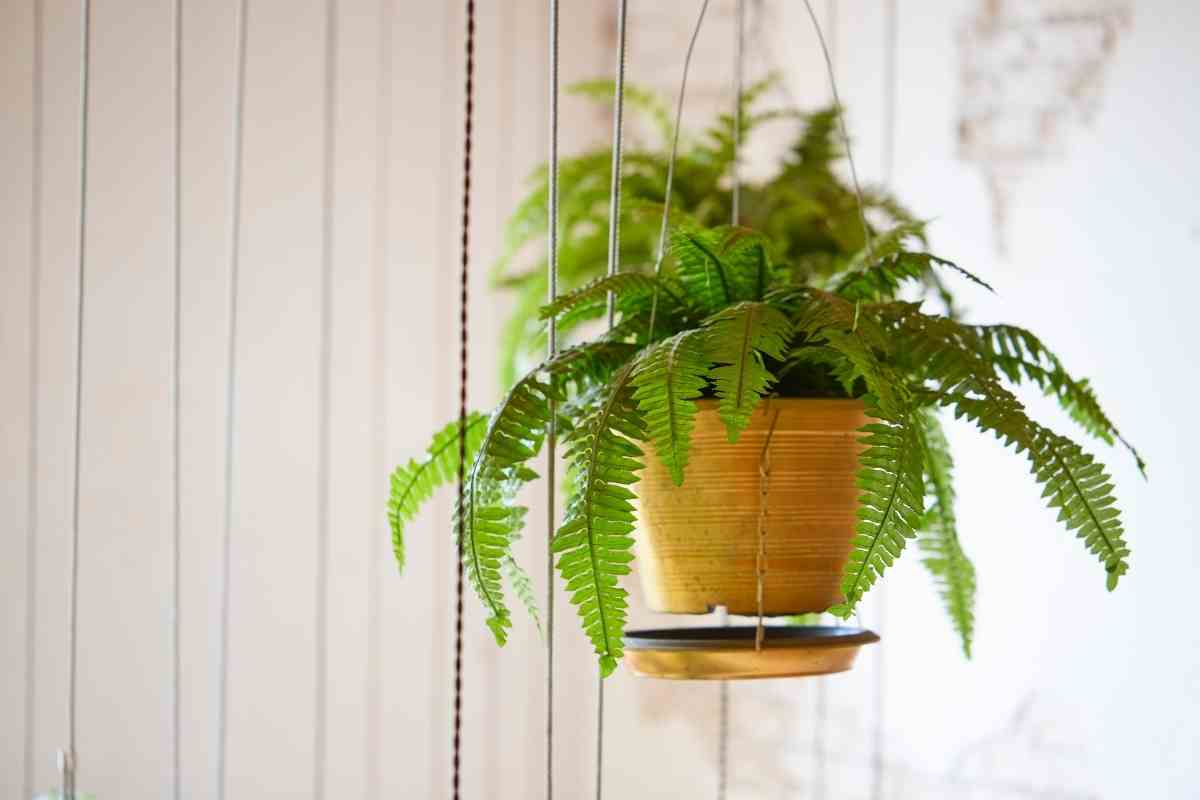Boston ferns are a popular houseplant because they are easy to grow and add a touch of greenery to any room, porch, or garden.
If you’re new to growing Boston ferns, this guide will teach you everything you need to know about how to care for them.
We’ll cover everything from potting soil to watering frequency, so you can keep your fern healthy and looking its best.
Let’s get started!
Where Did Boston Ferns Originate?
Boston ferns are a species of fern that is native to tropical regions.
The Boston fern gets its name from the city in which it was first introduced to the Western world, Boston, Massachusetts. Boston ferns are popular houseplants.
The main reason is that they are relatively easy to care for. Also, Boston Ferns can thrive in a wide range of indoor environments.
Parts of a Boston Fern
Boston ferns have an unusual, yet elegant shape that you might not be too familiar with.

There are four main parts to a Boston fern:
- Blade: This is the term for the leafy part of the Boston fern.
- Pinna: The term for each horizontal leaf on the plant.
- Stalk: The stalk is the main stem of the plant that all of the Pinnas are connected to.
- Frond: This refers to the entire plant above the soil. From the bottom of the stalk to the very tip of the blade. Boston fern fronds can grow up to 3 feet long and are usually a deep green color.
Varieties of Boston Ferns
There are many different varieties of Boston ferns, including the Boston Sword Fern, Boston Compacta Fern, and Boston Staghorn Fern:
- The Boston Sword Fern is the most common variety of Boston fern and can grow up to three feet tall.
- The Boston Compacta Fern is a smaller variety of Boston fern that only grows to about one foot tall.
- The Boston Staghorn Fern is a rarer variety of Boston fern that gets its name from the antler-like shape of its leaves.
Are Boston Ferns Toxic to Pets?
Boston ferns are not toxic to people or pets, making them a safe plant to have around if you have kids, cats, or dogs.
They are also safe to leave on front porches where you may be visited by other wildlife like squirrels, chipmunks, rabbits, and deer.
Caring for Boston Ferns

Boston ferns are incredibly easy to care for and will usually thrive in the wild with no assistance.
But taking it out of the wild where it gets shade from trees and water from the rain and putting it in a pot will require minimal effort on your part.
Watering
Water Boston ferns regularly but allow the potting mix to dry out slightly between watering.
Boston ferns prefer to be kept moist, but not wet.
Boston ferns that are allowed to dry out completely will develop brown tips on their leaves and if they are overwatered the roots will begin to rot, and the plant will start to turn yellow.
Soil Type
The best type of soil for Boston ferns is light and fast draining.
Regular garden soil would be suitable only if you add in coco coir or perlite to lighten it up.
Boston ferns do not like to sit in wet soil so make sure the potting mix you use has good drainage.
Sunlight
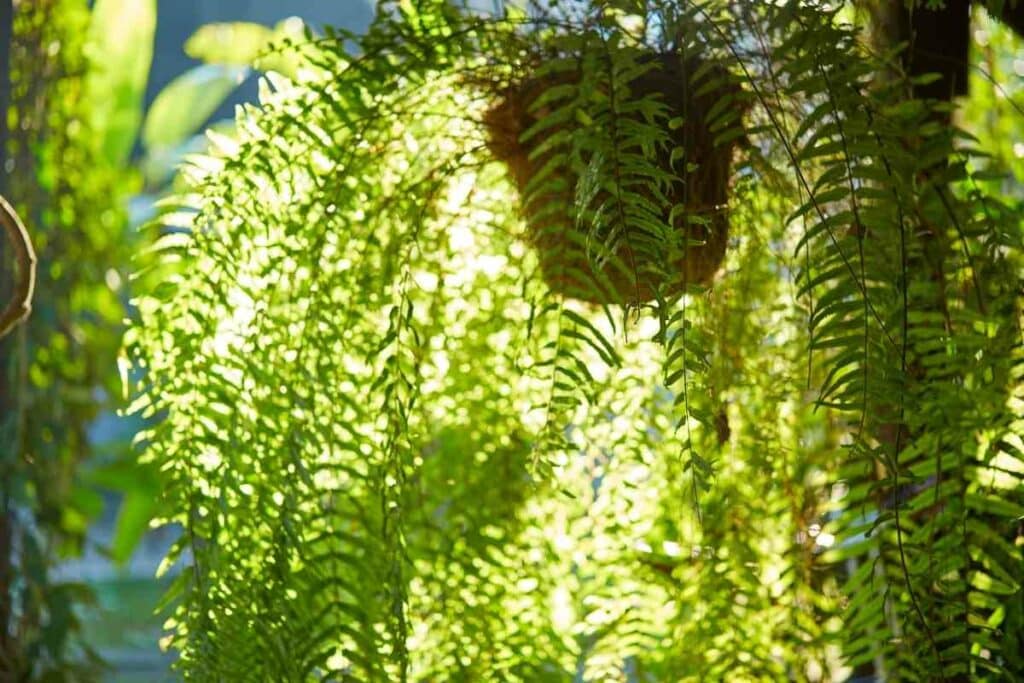
Boston ferns are used to staying mostly shaded from tree canopies, so it makes sense that Boston ferns prefer bright, indirect light.
If your Boston fern is exposed to direct sunlight the leaves will start to turn brown, as though they are cooking.
If you notice your Boston fern is rapidly growing taller without new leaves or is beginning to flop, it isn’t getting enough sunlight.
Fertilizer
Boston ferns aren’t heavy feeders, and they won’t need to be fertilized often, especially if you have compost materials in the soil you’re using.
If you haven’t changed the soil in a while, or if you notice your plant hasn’t grown much, you can add a little bit of fertilizer.
This one is good for indoor or potted Boston ferns. Use 1 pump for a small plant and 2 pumps for a large one and water as usual.
This is instant fertilizer, so the nutrients are used as soon as they are put in the soil.
Reapply weekly or as needed, but you shouldn’t need to apply more than a few times a year.
Humidity and Temperature
Boston ferns prefer to sit somewhere with high humidity and temperatures between 60-80 degrees Fahrenheit.
Boston ferns that are exposed to dry air will develop brown tips on their leaves, so if your house is dry, make sure you add a humidity tray.
The best spot in the house for a Boston fern is in the bathroom, especially if someone in your home likes to take hot showers.
The steam will make the bathroom nice and humid for your Boston fern.
You can also help your Boston fern by misting it daily. By lightly misting the leaves all over, you’ll add moisture to the air around your Boston fern and help it to thrive.
Pruning
Boston ferns will need to be pruned regularly to keep them looking their best.
Boston ferns can become lanky and leggy if they are not pruned. To prune Boston ferns, simply cut back the longest leaves to the desired length with a sharp pair of scissors.
Start by cutting off the unsightly brown tips, then work your way back to the healthy green leaves.
Works Best – Maintenance pruning can be done year-round as needed, but major pruning should be done in the spring. This will encourage new, bushier growth over the summer.
Choosing a Pot
When you buy a Boston fern, it will very likely come in a hanging basket made of coco coir.
It is possible to keep a Boston fern healthy in one of these baskets, but unless you’re an experienced gardener it might be wise to get a new pot.
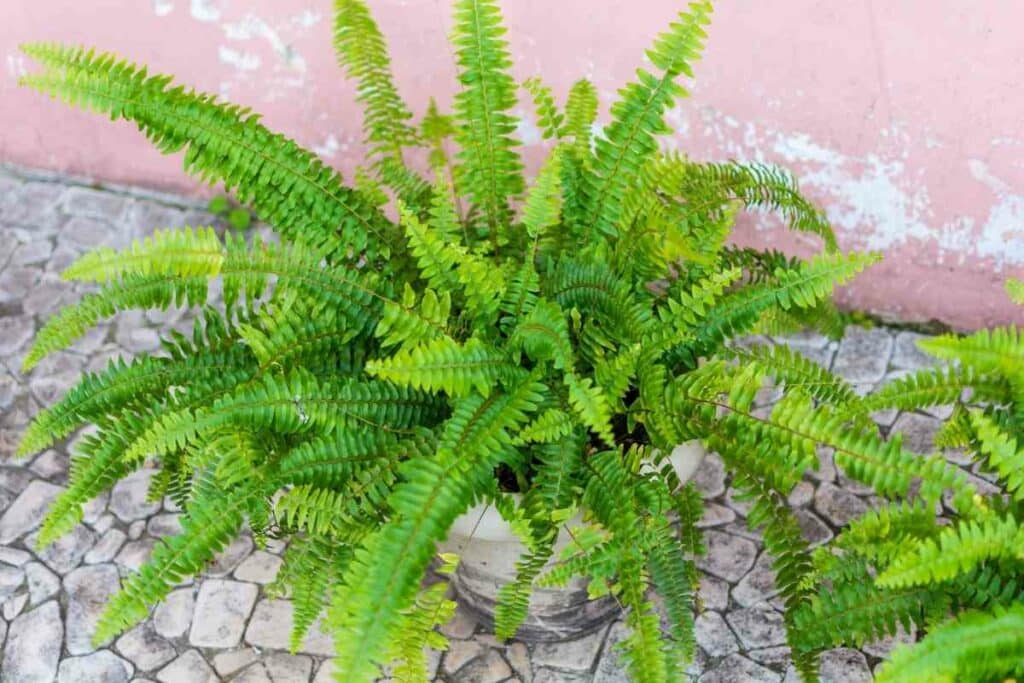
If you’re going to repot your plant, opt for a plastic or a glazed terra cotta pot.
These types of pots will take longer to dry out than coco coir baskets, which means there is moisture available for longer when your fern needs it.
Repotting
Boston ferns will continue to grow as long as there is more room in the pot.
But don’t plant a small Boston fern in a large pot.
What will happen is the roots will continue to grow, but the Boston fern will stay small because it doesn’t have enough leaves to support the larger amount of roots.
Instead, plant the Boston fern in a pot that is only one size larger than the current pot. Then as your Boston fern grows, repot the plant every two or three years.
Boston ferns can be sensitive to changes in their environment, so it is best to repot them in the spring.
Propagating
The easiest way to propagate new Boston ferns is by division, which is a method of vegetative reproduction that involves splitting an existing plant into multiple parts and then replanting those parts.
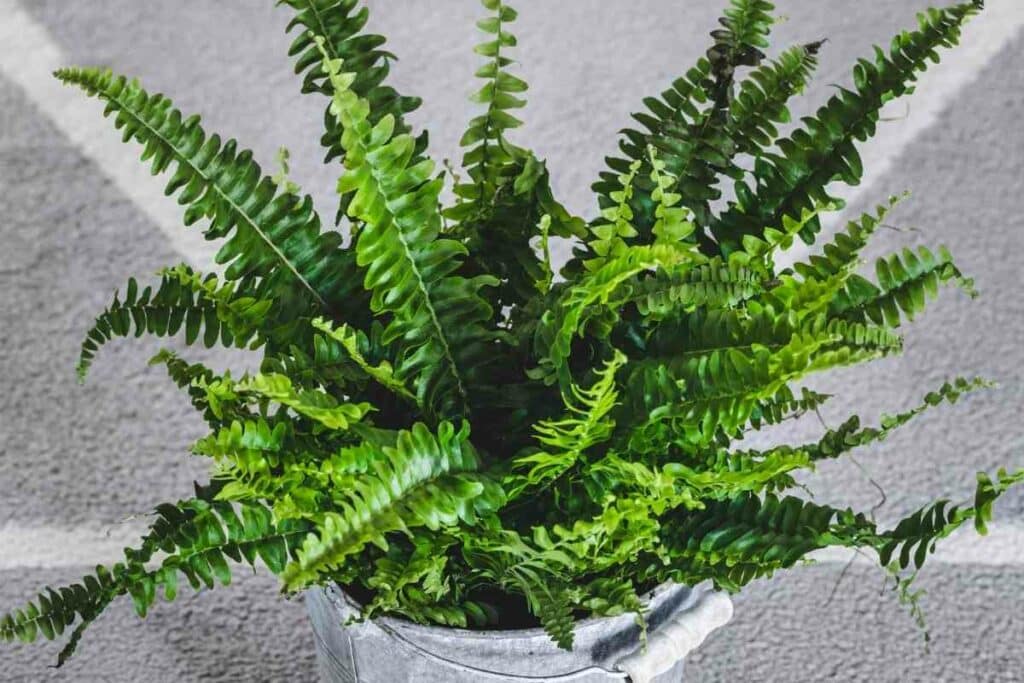
To divide a Boston fern:
- First, carefully remove the plant from its pot.
- Next, use a sharp knife or gardening tool to divide the Boston fern into two or more parts.
- Once the Boston fern has been divided, replant each section in its own pot filled with fresh potting mix.
This should be done in the spring to give your Boston fern time to adjust before its growing period.
Growing Boston Ferns from Seed
That might be a little misleading; Boston ferns don’t actually have seeds, instead, they grow from spores.
Before you begin harvesting and growing Boston ferns from spores, gather these materials:
- a sheet of paper or paper towel
- a container
- a small pot
- potting soil
- misting spray bottle
You also need access to an adult plant that is well established so you can collect the spores.
Once you have everything, follow these steps:
- Hold the paper or paper towel under a frond of the Boston fern and shake the frond delicately to make the spores fall off.
- Shake the paper or paper towel off into the container to hold the spores until you’re ready to use them.
- Get your pot ready by filling it with potting soil, watering the soil, and finding the right spot for it in your house.
- Shake the spores onto the damp soil.
- Keep the soil damp at all times by using the mister. If you use too much water pressure, you can damage the spores and they won’t grow.
- In about a week, you’ll start to notice a green film on the top of the soil. This isn’t mold, it’s the beginning of a new plant!
- Continue to mist the plant until you see sprouts growing. At this point, you can stop misting and water normally.
Boston Fern Common Issues and Solutions
Boston ferns are strong plants that are relatively easy to grow, but if their needs aren’t met, they can still experience problems.
Here are some common Boston fern issues and how you can fix them.
Brown Leaves
One of the most common problems Boston ferns experience is brown leaves.
If the leaves are dry and crispy, it’s usually a watering issue or a light issue. Boston ferns like to stay moist, so make sure you’re watering your plant regularly.
They also prefer indirect light, so if you’re keeping your Boston fern in a sunny spot, that could be the problem.
Move your plant to a shadier spot and increase watering to see if that solves the issue.
Brown Spots Under the Leaves
It would be more concerning if your Boston fern didn’t have brown spots under the leaves.
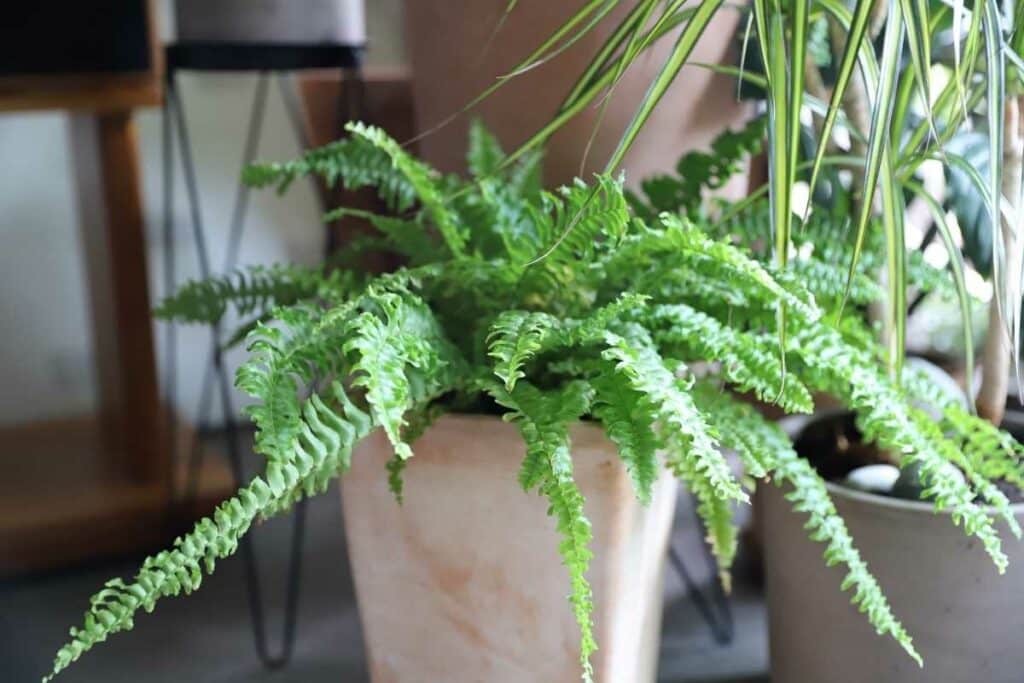
These are the plants’ spores and when they fall into the dirt, and they receive water, they turn into new plants.
Dropping Leaves
If Boston fern leaves are dropping, it’s a sign of too much light or dry air.
Boston ferns like humid environments, so if the air in your home is dry, you can increase humidity by placing the pot on a tray of pebbles and water or using a humidifier.
From Experience – You should also move your Boston fern to a spot with indirect light and cut back on how much you are watering the plant to see if that solves the issue.
Yellow Leaves
If the leaves of your Boston fern are turning yellow, this could be a sign that the health of the roots is declining.
Boston ferns are sensitive to chemicals, so if you’ve been using fertilizers or pesticides, that could be the issue.
Roots can also rot if the pot doesn’t have adequate drainage or if the plant is sitting in water.
If you think this is the problem, replant your Boston fern in a pot with a drainage hole and fresh potting mix.
Pests and Diseases
Boston ferns are susceptible to mealybugs, aphids, and spider mites.
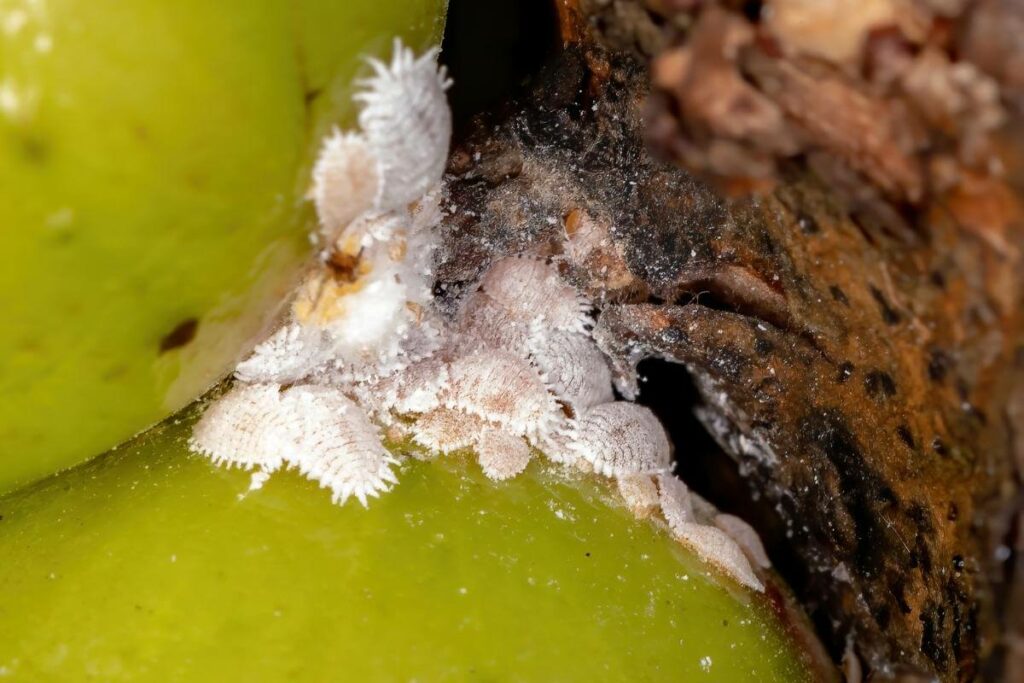
Boston ferns that are overwatered are also more susceptible to fungal diseases such as root rot.
To prevent pests and diseases, make sure you are not overwatering your Boston fern and only fertilize the plant when it is actively growing.
If you do notice pests or diseases on your Boston fern, isolate the plant from other houseplants and treat the problem with an appropriate pesticide or fungicide.
Final Thoughts
Boston Ferns are a great addition to any home, garden, porch, or office.
They’re easy to care for, and with a little TLC, they can last for years.
If you experience any problems with your Boston ferns, be sure to read the section on common Boston fern issues and solutions.
With a little bit of know-how, you should be able to troubleshoot any problem your Boston fern might have.
Thanks for reading!
